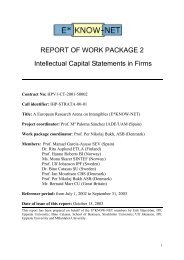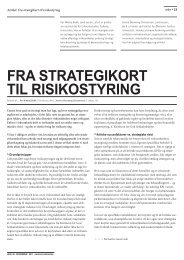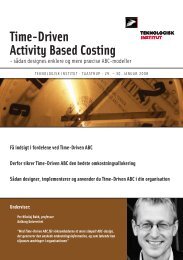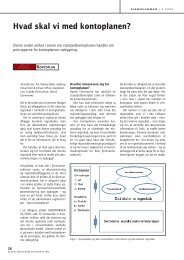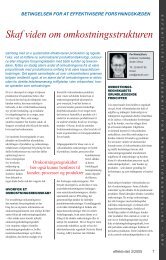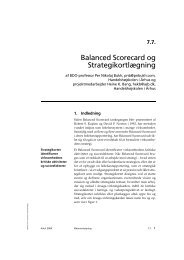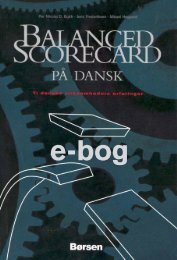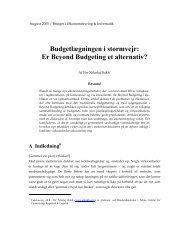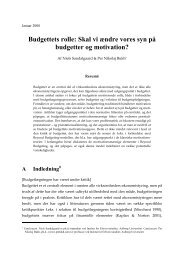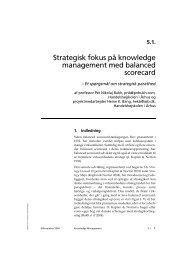guidelines for managing and reporting on intangibles (intellectual
guidelines for managing and reporting on intangibles (intellectual
guidelines for managing and reporting on intangibles (intellectual
Create successful ePaper yourself
Turn your PDF publications into a flip-book with our unique Google optimized e-Paper software.
possibility of insider trading, avoiding biased or wr<strong>on</strong>g earnings estimates, inefficient<br />
valuati<strong>on</strong>s <str<strong>on</strong>g>and</str<strong>on</strong>g> unjustified volatility. This would c<strong>on</strong>tribute to an increased social<br />
awareness of intangible investments which would facilitate both, a greater efficiency in<br />
the allocati<strong>on</strong> of ec<strong>on</strong>omic resources <str<strong>on</strong>g>and</str<strong>on</strong>g> the design <str<strong>on</strong>g>and</str<strong>on</strong>g> implementati<strong>on</strong> of public<br />
policies.<br />
To help companies develop their capability to identify, measure <str<strong>on</strong>g>and</str<strong>on</strong>g> c<strong>on</strong>trol their<br />
<strong>intangibles</strong> <str<strong>on</strong>g>and</str<strong>on</strong>g> to supply comparable in<str<strong>on</strong>g>for</str<strong>on</strong>g>mati<strong>on</strong> to their providers of capital, these<br />
Guidelines have to rest necessarily <strong>on</strong> a comm<strong>on</strong> c<strong>on</strong>ceptual background. The next<br />
secti<strong>on</strong> presents the c<strong>on</strong>ceptual framework of the Guidelines.<br />
3. C<strong>on</strong>ceptual Framework<br />
During the last few decades we have witnessed an unprecedented increase in the use of<br />
the terms <strong>intangibles</strong>, <strong>intellectual</strong> capital or knowledge in reference to a set of factors<br />
that represent sources of corporate earnings. However, these terms are frequently<br />
employed indifferently, without a clear definiti<strong>on</strong>, not always homogeneously, <str<strong>on</strong>g>and</str<strong>on</strong>g> often<br />
applied to different c<strong>on</strong>cepts. For this reas<strong>on</strong> it is essential to agree up<strong>on</strong> comm<strong>on</strong><br />
definiti<strong>on</strong>s.<br />
The terms Intangibles <str<strong>on</strong>g>and</str<strong>on</strong>g> Intellectual Capital are used to refer to the same c<strong>on</strong>cept.<br />
Both are applied to n<strong>on</strong>-physical sources of future ec<strong>on</strong>omic benefits that may or may<br />
not appear in corporate financial reports. However, these two terms tend to be used<br />
differently: Intangibles is an accounting term, whereas the Intellectual Capital was<br />
coined in the human resources literature <str<strong>on</strong>g>and</str<strong>on</strong>g> is mainly used in this field (Vickery,<br />
1999). However, it is c<strong>on</strong>venient to take into account that when the term Asset is<br />
associated to Intangible, it should <strong>on</strong>ly refer to intangible investments that, according to<br />
accounting st<str<strong>on</strong>g>and</str<strong>on</strong>g>ards, may be recognized <str<strong>on</strong>g>and</str<strong>on</strong>g> reflected in the firm’s balance sheet.<br />
There<str<strong>on</strong>g>for</str<strong>on</strong>g>e, while Intangibles <str<strong>on</strong>g>and</str<strong>on</strong>g> Intellectual Capital can be c<strong>on</strong>sidered to be<br />
equivalent, the c<strong>on</strong>cept Intangible Asset is more restrictive, representing the set of<br />
Intangibles or elements of Intellectual Capital that are susceptible of being recognized<br />
as assets in accordance with the current accounting model. 9<br />
3.1. Intangibles<br />
There is no broadly accepted definiti<strong>on</strong> of Intangibles. It is actually an adjective that<br />
goes al<strong>on</strong>g with different c<strong>on</strong>cepts, such as assets, activities, resources, etc. However,<br />
the adjective is often used as a noun, <str<strong>on</strong>g>and</str<strong>on</strong>g> this is good proof of the significant difficulties<br />
that exist when trying to determine a correct definiti<strong>on</strong> (Cañibano <str<strong>on</strong>g>and</str<strong>on</strong>g> Sánchez, 1998).<br />
Nevertheless, the wide variety of definiti<strong>on</strong>s of Intangibles that can be found in the<br />
literature have some comm<strong>on</strong> features (Cañibano, Garcia-Ayuso <str<strong>on</strong>g>and</str<strong>on</strong>g> Sanchez, 2000a).<br />
They are generally defined as n<strong>on</strong>-m<strong>on</strong>etary sources of probable future ec<strong>on</strong>omic<br />
profits, lacking physical substance, c<strong>on</strong>trolled (or at least influenced) by a firm as a<br />
result of previous events <str<strong>on</strong>g>and</str<strong>on</strong>g> transacti<strong>on</strong>s (self-producti<strong>on</strong>, purchase or any other type of<br />
acquisiti<strong>on</strong>) <str<strong>on</strong>g>and</str<strong>on</strong>g> may or may not be sold separately from other corporate assets.<br />
9 Hereafter, it will be assumed that Intangibles <str<strong>on</strong>g>and</str<strong>on</strong>g> Intellectual Capital represent similar c<strong>on</strong>cepts <str<strong>on</strong>g>and</str<strong>on</strong>g>,<br />
c<strong>on</strong>sequently, they will be used indifferently throughout this document.<br />
9



